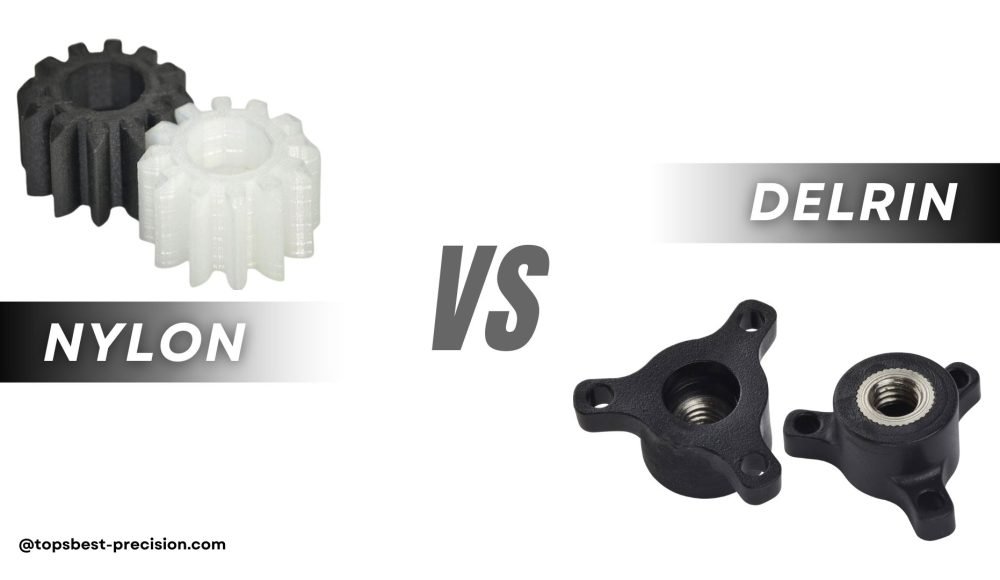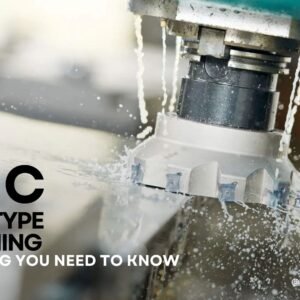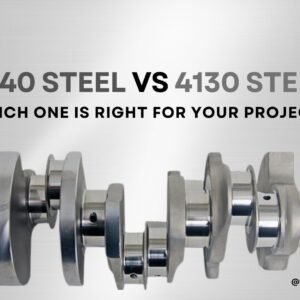Le Delrin et le Nylon sont les plastiques de qualité technique les plus fréquemment utilisés dans l'usinage et le moulage par injection.. Le nylon est un polyamide tandis que le Delrin est un homopolymère d'acétal.. Les deux matériaux présentent des caractéristiques assez marquantes. Le nylon est chimiquement solide et résistant, offrant une résistance élevée à la traction et est généralement solide et durable.. Delrin est célèbre pour sa résistance exceptionnelle à l'usure.
En plus, les deux matériaux ont une assez bonne stabilité aux UV et résistent aux produits chimiques toxiques. Ils présentent également un faible coefficient de friction, ce qui est bénéfique dans diverses applications. Les ingénieurs et les concepteurs doivent comparer soigneusement le Delrin et le nylon. Cet article vous guidera dans la sélection du matériau adapté à vos besoins.
Qu'est-ce que le nylon?
Le nylon est un produit synthétique du polyamide issu de la polymérisation par condensation. Le procédé utilise des acides dicarboxyliques et des diamines comme monomères. Sur l'intégrité structurelle, le nylon a une excellente résistance aux produits chimiques et à la chaleur grâce à sa base solide. Cependant, l'absorption d'humidité diminue la stabilité du matériau. Ces problèmes doivent être bien résolus par des traitements de préconditionnement pour améliorer ses performances.
Qu'est-ce que le Delrin?
Delrin est un polymère acétal. Il est scientifiquement connu sous le nom de polyoxyméthylène ou POM.. En raison des caractéristiques découvertes, il est particulièrement adapté à une utilisation dans les processus d'usinage et de moulage par injection. Delrin est livré avec des options d'homopolymère et de copolymère.
En outre, Le Delrin est un polymère semi-cristallin qui possède un degré de régularité cristalline élevé., ce qui donne au matériau sa couleur blanche opaque caractéristique. Différentes couleurs sont possibles pour des usages commerciaux. Grâce à son faible frottement et sa grande rigidité, Le Delrin est idéal pour une utilisation dans des pièces précises.
Comparaison directe entre le nylon et le Delrin
| Propriété | Nylon | Delrin |
| Résistance chimique | Très résistant aux produits chimiques | Excellente résistance aux produits chimiques et aux solvants |
| Résistance à la température | Fonctionne entre 180°F et 190°F | Fonctionne à des températures légèrement inférieures |
| Absorption d'humidité | Absorbe jusqu'à 8% humidité | Absorbe seulement environ 0.2% humidité |
| Résistance à la traction | 12,000 psi | 10,000 psi |
| Usinabilité | Facilement usinable, moins précis | Excellente usinabilité, haute stabilité dimensionnelle |
| Résistance à l'usure | Meilleure résistance à l’usure dans des conditions sèches | Résistance à l’usure légèrement moindre lorsqu’elle n’est pas remplie |
| Propriétés de friction | Faible résistance de contact | Faible résistance de contact |
| 3D Capacités d'impression | Compatible avec diverses méthodes d'impression 3D | Nécessite une préparation supplémentaire pour l’impression 3D |
| Applications | Utilisé dans le textile, automobile, et ingénierie | Préféré pour les pièces de précision comme les engrenages et les roulements |
Le nylon et le Delrin offrent tous deux des avantages distincts pour diverses applications de fabrication. Comprendre leurs propriétés vous aidera à choisir le matériau adapté aux besoins de votre projet.
Avantages & Inconvénients du nylon vs. Delrin:
Avantages du Delrin
- Conception légère: Peu de matériaux sur le marché sont plus légers que le Delrin. En raison de sa haute densité, il présente une résistance à la traction incroyable et peut facilement supporter les chocs et les impacts.
- Excellente résistance à la traction: La résistance à la fatigue du Delrin est considérablement élevée, ce qui le rend adapté aux applications qui nécessitent des performances et une durabilité élevées.
- Excellente usinabilité: Le Delrin est facile à traiter avec différentes méthodes d'usinage. Cela conduit à la fabrication précise de composants robustes.
- Capacité élevée de contrainte et de déformation: Le Delrin est bien plus performant que les métaux en matière de stress. Sa caractéristique de reprendre sa forme originale après déformation le rend idéal pour une utilisation dans les pièces à clipser et à boucler..
- Résistance à l'humidité: Le Delrin est un matériau idéal car il n’absorbe pas l’humidité. Cela le rend idéal pour les zones humides. Sa résistance chimique ajoute à la durabilité globale dans plusieurs processus de fabrication.
Limites du Delrin
- Résistance limitée à l'abrasion: Delrin peut ne pas fonctionner efficacement dans des situations de friction élevée, ce qui peut limiter son application dans certaines applications de construction ou industrielles..
- Faible stabilité thermique: Le Delrin a une température de transition vitreuse relativement basse et peut ne pas être idéal pour les applications à haute température..
Avantages du nylon
- Facilité de fabrication: Le Delrin peut être teint ou coloré facilement, ce qui en fait une option plus personnalisée pour produire des pièces précises dans un délai minimal.
- Compatibilité avec l'impression 3D: Le nylon permet différents types d'impression. Ainsi, il permet la formation de motifs complexes, ainsi que des formes complexes.
- La flexibilité: Le nylon est polyvalent par nature.. Donc, il peut donner de bons résultats dans les zones pouvant nécessiter une flexion ou un étirement pour offrir une bonne résilience dans diverses conditions.
- Propriétés à faible friction: Grâce à son faible coefficient de friction, le nylon est couramment utilisé dans les parties de produits où un fonctionnement est requis avec un minimum de forces de friction.
Inconvénients du nylon
- Usinabilité difficile: Le nylon ne peut pas être traité aussi facilement que la plupart des matériaux hautes performances, ce qui peut poser problème lors du traitement.
- Sensibilité à l'humidité: Le nylon a une mauvaise résistance aux caractéristiques d'absorption de l'humidité, ce qui peut réduire sa fonctionnalité et sa stabilité en cas d'exposition à l'humidité., surtout dans les zones à forte humidité.
Applications du Delrin
Delrin trouve des applications dans de nombreuses pièces vitales dans différentes industries manufacturières. Voici quelques applications courantes:
- Pièces automobiles: Ceux-ci se trouvent dans les engrenages des fenêtres, grillades, et pièces de ceinture de sécurité de l'automobile.
- Machines industrielles: Intégré au matériel agricole, composants du moteur, roulements, et engrenages de précision.
- Dispositifs médicaux: Utilisation dans les systèmes d'administration de médicaments et autres instruments médicaux.
- Produits de consommation: Appliqué dans la fermeture éclair, boutons de porte, et applications de vannes.
- Composants électriques: Utilisé pour le changer, support de circuit, et autres boîtiers d'appareils électriques.
Applications en nylon
Le nylon est largement utilisé dans diverses industries car c'est un matériau haute performance. Voici quelques utilisations:
- Quincaillerie en plastique: Spécialisé dans la production de nombreuses composantes en plastique pour divers secteurs.
- Composants automobiles: Utilisé dans certaines parties des moteurs, engrenages, et structures de la voiture.
- Ustensiles de cuisine: Le nylon est utilisé dans la fabrication d'ustensiles de cuisine et d'autres équipements de cuisine résistants.
- Attaches: Utilisé lors de la fabrication de vis et de boulons, entre autres fixations.
- Engrenages mécaniques: Le nylon est utilisé dans des matériaux légers, applications à haute résistance telles que les engrenages et autres composants de transmission de puissance.
Nuances Delrin pour le prototypage rapide
Delrin propose de nombreuses qualités pour répondre aux exigences du prototypage rapide. Les qualités courantes de Delrin incluent:
Delrin 150
Delrin 150 est la norme pour le Delrin et convient aux applications générales. L'usinabilité est très bonne et présente une grande précision dimensionnelle. Cette nuance est parfaite pour les pièces qui nécessitent de la précision.
Delrin 511P
Delrin 511P offre également une stabilité dimensionnelle plus élevée et un impact amélioré, et la force. Il est principalement utilisé dans les moteurs où la pièce est très usée..
Delrin 570
Delrin 570 est doté d'un matériau renforcé de verre pour augmenter sa résistance. Il présente une rigidité et une stabilité dimensionnelle élevées lorsqu'il est soumis à des contraintes élevées..
Delrin AF
Delrin AF est une combinaison de PTFE pour un faible frottement ainsi que des propriétés d'usure améliorées. Il est idéal pour être utilisé dans tout processus impliquant un mouvement fluide ou de faibles niveaux de friction.. Cette qualité est normalement appliquée aux engrenages et aux roulements.
Nuances de nylon pour le prototypage rapide
Il existe trois des qualités les plus couramment utilisées dans le prototypage rapide :.
Nylon 6
Nylon 6 est un homopolymère dérivé du caprolactame à six carbones. Cette qualité a une cristallinité inférieure à celle des autres qualités et se caractérise donc par un taux d'absorption d'humidité élevé..
Nylon 6,6
Nylon 6,6 est formulé par une réaction entre le chlorure d'adipoyle et l'hexaméthylène diamine. Il est célèbre pour sa résilience et possède une large gamme de stabilité thermique et d’humidité.. Le matériau présente également une très bonne stabilité à haute température.
Nylon 12
Nylon 12 est synthétisé par polymérisation de lactame laurique avec des unités 12-méthylène. Il est très résistant aux chocs, y compris à basse température. De plus, nylon 12 a une bonne résistance aux fissures et est relativement suffisamment durable pour produire des produits très fiables.
Delrin contre. Nylon: Comment faire un bon choix?
Le choix entre le Delrin et le Nylon dépend généralement des exigences spécifiques du projet.. Les deux matériaux présentent des caractéristiques qui les rendent adaptés à différentes applications. Choisir le bon signifie obtenir les meilleurs résultats dans votre processus particulier.
Delrin a une stabilité dimensionnelle élevée, résistance aux chocs, et faible absorption d'humidité. Il possède une grande résistance chimique et reste stable au fil des années. Alors que le nylon fonctionne de manière optimale sous frottement ou friction. Il est idéal pour les applications nécessitant des pièces durables, comme des engrenages imbriqués. Vous apprécierez combien de temps cela dure, même sous pression ou dans des conditions extrêmes.
Le Delrin est plus résistant que le nylon. Les nylons ont 12000 résistance à la traction psi alors que Delrin implique 10000 résistance à la traction en psi. Chaque matériau est avantageux de différentes manières en fonction de la nature de l'opération de projet en cours.. En particulier dans la modélisation des dépôts fondus (FDM), les pièces subissent une flexion importante. Pour cette raison, le matériau doit pouvoir être à la fois solide et élastique. Ces demandes sont effectivement, requis en utilisation active, contrairement au Delrin qui est plus fragile et peut ne pas bien résister aux flexions répétées.
Résumé
Dans cette comparaison détaillée, vous pouvez maintenant considérer vos besoins particuliers. Comme mentionné précédemment, chaque matériau excelle dans des applications spécifiques. La sélection du matériau approprié est très importante pour votre travail. Nous disposons également d'une équipe de techniciens professionnels pour fournir un excellent usinage pour les matériaux Delrin et nylon à Précision au sommet. Nous vous accompagnons depuis l’approvisionnement en matières premières jusqu’à la production d’une pièce donnée. Contactez-nous pour un devis instantané, et nous vous répondrons dans les 12 heures d'ouverture.
FAQ
T1. Comment distinguer le nylon du Delrin par sa résistance?
Le nylon a une plus grande résistance à la traction, à propos 12,000 psi, que Delrin qui a environ 10,000 psi. Cela rend le nylon mieux adapté aux applications soumises à de fortes contraintes que le Delrin..
T2. Lequel des deux Nylon ou Delrin est le plus optimal pour les températures élevées?
Le nylon a une résistance à des températures plus élevées. Il est donc plus approprié pour une utilisation à haute température. Autant le Delrin est très sensible à la chaleur, il n'est pas bien adapté aux applications à haute température.
T3. Est-il possible d'utiliser Delrin dans des applications flexibles?
Delrin a une bonne stabilité dimensionnelle, mais il ne possède pas la flexibilité du matériau en nylon. Pour les candidatures, dans lequel il existe un besoin de pliage continu, Le nylon est normalement plus adapté.
T4. Le nylon est-il plus adapté à l'usinage que le Delrin?
Le Delrin est facile à usiner car il conserve sa taille et possède une résistance élevée à la traction..
Q5. Quelle est la comparaison entre le nylon et le Delrin en termes d'absorption d'humidité ??
Delrin absorbe moins d’eau, ce qui le rend idéal pour les environnements humides. Le nylon absorbe plus rapidement l'humidité que le polyester, ce qui peut affecter ses performances dans des environnements relativement humides..



